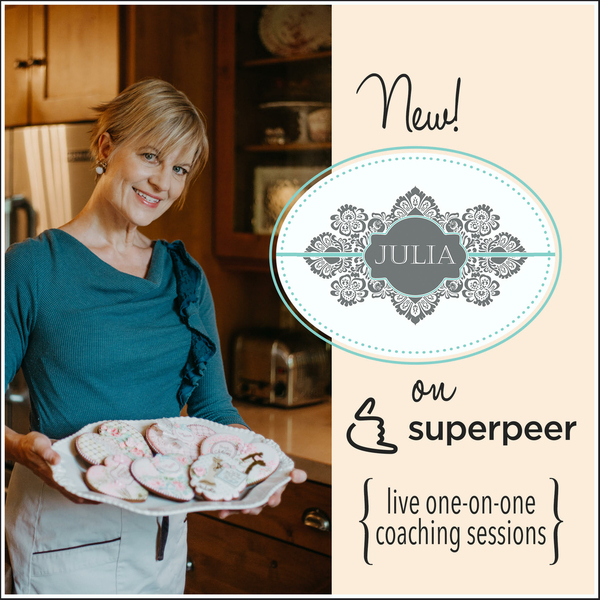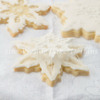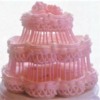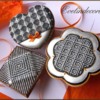But before I mention the details of this challenge, let's talk about our AMAZING PRIZE! One lucky entrant will be chosen at random from among all of the challenge entrants to receive a one-hour mentoring call ($100 value) with our very own Cookie Connection founder @Julia M. Usher on Superpeer!

Superpeer is a booking platform where you can schedule one-on-one video calls with the world’s best experts, influencers, and professionals. And that means Julia! Julia's sessions aren't classes. They are rare opportunities for you to connect with her to explore a focused topic (or two) in much greater detail than you could on email or via text. Anyone, not just our challenge winner, can book a session at any time; just be sure to very specifically identify the topic(s) you want to address with Julia when you book. That way, she can gather resources or prep materials that might be helpful to share during the call.
THANK YOU, Julia, for generously donating this prize! The winner will be extremely lucky to spend an entire hour learning from a world-renowned sugar artist!
And now, on to the details of our challenge . . .
According to this post by Penny Stankiewicz of the Institute of Culinary Education, royal icing stringwork is a decorating process that "involves delicate piping of royal icing, through a very small piping tip, built up upon itself to reach breathtaking gravity-defying heights. The two main forms of this highly skilled technique are Australian stringwork and oriental stringwork."
Australian stringwork involves piping strings from a cake (typically) to a curved platform or "bridge" below. This post by Pauline Soo of Pauline Bakes the Cake explains both "bridge" extension work and "bridgeless" stringwork, and offers some excellent step-by-step photos. This video by Auntie's Cakery also teaches how to pipe bridge extension stringwork. What I really like about this video is that it also offers valuable tips, such as how to achieve the right icing consistency, how to "paddle" the icing to remove air bubbles, how to make a parchment cone, and much more. Once you have mastered bridge extension work, this Cookie Connection post and video by @bobbiebakes will teach you how to pipe gravity-defying bridgeless stringwork!
As Penny Stankiewicz further explains in her post, "oriental string work is similar with its use of fine strings piped with royal icing, but in this case, the strings are dropped to create a curve. Dots are piped to attach the strings away from the cake and added layer by layer, actually turning the cake upside down [sic] during part of the process so the strings hang from the top and bottom creating elegant curves in both directions." In this video by @bobbiebakes, we learn the secrets behind the gravity-defying oriental stringwork technique. And in this video, Certified Master Sugar Artist Peggy Tucker offers many tips including her secret for "silky" icing that flows beautifully from the piping tube. I recommend watching the entire video since it offers a wealth of information as Peggy walks you through the entire process step by step. Additionally, instructor Toba Garrett offers a course through Craftsy® that teaches how to create stunning oriental stringwork designs. And this tutorial, with accompanying video, by @Sweetopia is a great example of how oriental stringwork can be piped onto a cookie, literally taking your cookie art to a whole new level!
In researching for this challenge, I found that most sugar artists tend to stay true to traditional Australian and oriental stringwork designs, however, I believe this technique can look equally stunning when done in a more contemporary style such as this cake by cake artist and instructor @Dora. Two of my personal favorite stringwork cookies that I have created are these Spirograph® cookies because they look a lot more complicated than they really are. This video breaks down one of the designs, and shows how simple and straightforward the pattern really is.
Here are a few other examples of stringwork cookies from our own Cookie Connection members:
Suspended Stringwork Snowflake Cookies by bobbiebakes Here is the tutorial that shows how this gravity-defying stringwork was done.
Here is the tutorial that shows how this gravity-defying stringwork was done.

The same effect was used to create this three-tier cookie.
Christmas Candles by Anikó Vargáné Orbán This set is an excellent example of how both the cookie and the stringwork design can work beautifully in conjunction with one other.
This set is an excellent example of how both the cookie and the stringwork design can work beautifully in conjunction with one other.
Optical Illusion Cookies by Evelindecora These cookies are a great example of how geometrical patterns can be piped directly onto the cookie to create a contemporary look.
These cookies are a great example of how geometrical patterns can be piped directly onto the cookie to create a contemporary look.
Blue Star by Sweet Prodigy Here, I used each layer of stringwork as a "bridge" to help build upon and support each subsequent layer.
Here, I used each layer of stringwork as a "bridge" to help build upon and support each subsequent layer.
Now that you are familiar with the technique of stringwork, let's turn our attention to the medium that you will be using to create your masterpiece.
There are countless royal icing recipes and tutorials to be found online, however, I found this video by @Julia M. Usher to be filled with some great information and many wonderful tips about how to make perfect royal icing. Additionally, this post by Veena Azmanov offers recipes for several types of royal icing, including one with raw eggs, another with meringue powder, and a vegan royal icing using aquafaba (chick pea liquid). Peggy Tucker uses glucose to make her icing "silkier" and flow much more smoothly from the tube, as referenced in the video link above. If you are like me and prefer to use icing that is a little bit thicker, then this post by @Sweetopia offers some great tips for removing air bubbles by using a spatula and silicone bowl. Icing consistency is also important. Many of the videos and tutorials mentioned above discuss and demonstrate the ideal consistency for piping traditional stringwork.
[EDITOR'S NOTE: In my experience, icing made with raw egg whites, as opposed to meringue or albumen powder, is more stretchy and less prone to breaking when piping stringwork. My theory is that the process of heating egg whites to create powdered or pasteurized forms weakens the protein strings in egg whites. Also, I would caution against attempting stringwork with glaze, aka confectioner's icing, meaning icing with no egg or other protein in it. It is the egg protein that gives royal icing its resiliency and strength. That being said, many sugar artists have had success using vegan (protein-rich aquafaba-based) royal icing for stringwork. ~JMU]
- Use a metal piping tip for optimal results. A metal tip has a rigid opening, which means that the thickness of your stringwork will remain very consistent. (Traditionally, a round tip #0 is used for stringwork, however, you may find a tip #1 is easier to work with.)
- A quality piping tip can make all the difference. It is best to use a seamless tip, since a tip that has a seam may cause the icing to curl as it is pushed out of the tube. Additionally, a tip with dried icing, either on the inside or the outside of the tube, can also cause the icing to curl.
- Use fresh icing when piping stringwork.
- Start with a thick icing consistency and thin it down only as much as needed. Adding extra icing sugar to overly thin icing technically changes the recipe. Additionally, icing that starts off too thin will not be as strong when it dries.
- Adding too much coloring to your icing (especially darker colors) can cause the icing to break down and become brittle.
- Mistakes can be fixed. Carefully remove broken strings with a scribe tool or trussing needle.
- Experiment. Think outside the box. Look beyond the cake and cookie world for inspiration.
One more important thing to remember about stringwork is that your cookie(s) should contain no superfluous embellishments. The focus should be entirely on the delicate simplicity of the stringwork. With this in mind, the goal for this challenge is to capture the intricacy and delicacy of stringwork on a decorated cookie or cookie set by using either traditional stringwork techniques, such as Australian or oriental stringwork, or more modern approaches as shown above.
RULES:
PLEASE READ THEM CAREFULLY. I would hate to disqualify an entry because someone failed to read ALL of the rules.
1. Create one large-format cookie (greater than 12.5 centimeters or 5 inches) OR a set of three or more smaller cookies (each no less than 7 centimeters or 2 3/4 inches) using the stringwork technique. (No cakes, please.)
2. The predominant feature of your design (or preferably, your entire design) must be the stringwork technique. This means that multiple icing "strings", piped only with round tips, must be (1) suspended or piped away from the cookie, similar to Australian or oriental stringwork, and/or (2) be built up above the cookie surface by layering icing string upon icing string. I am NOT looking for one-level line work where the lines sit flush on the cookie, needlepoint grids, or Lambeth-style piping that typically uses non-round pastry tips.
3. Everything on the cookie(s) must be royal icing.
4. Your stringwork design must be original, and not a copy of any other artist's design.
5. As always, we ask that you make a brand new cookie project for this challenge.
6. And because Cookie Connection is all about learning and sharing, I would love for you to share in the comments section under your entry the different methods and techniques that you used, any tutorials or videos that guided you, and what you learned along the way.
TO ENTER:
- Please post an image of your cookie(s) to the site under the Practice Bakes Perfect clip set no later than February 28 at 5 pm central.
- Because these challenges are ongoing, we ask that you put "Practice Bakes Perfect Challenge #44" in your photo caption AND in a tag, so that we can tell the challenges apart from month to month. Please use the main title field to uniquely name your cookies as you normally would.
- Please also assign other relevant clip sets and tags to your images, as you normally would (meaning don't just use the Practice Bakes Perfect clip set and leave it at that, or your photos won't easily be found with keyword searches).
- You can enter more than once, but please post only one clip of each distinct entry. Multiple clips of the same entry are not allowed unless added in a comment beneath the one primary clip.
The prizes are given entirely at random. This means that everyone who participates in the challenge has an opportunity to be rewarded with this month's terrific prize!
After the challenge has closed on February 28, we will announce the winner in the Saturday Spotlight on March 6. The next challenge will be announced about a week after that Spotlight.
And, remember, these challenges are NOT a competition. They are intended to inspire and motivate you to step outside of your comfort zone, to experiment and be creative, and to try something new. The goal is for you to challenge yourself artistically and technically, and to develop your skills so that you may reach your full potential as a cookie artist. And, of course, the goal is for you to have fun along the way.
I can't wait to see what you create. If you have any questions about this challenge, or if you are looking for ideas, technical advice, or creative help - or if you just want to talk cookies - I would love to chat. You can leave me a comment below, or you can send me a private Cookie Connection message.

 Christine Dutcher's journey as a cookier began in early 2013 when an online search led her to the amazing world of cookie decorating. After spending countless hours learning all that she could, Christine decorated her first set of cookies in October 2013. In 2016, she decided that she would begin to focus on perfecting her skills, challenging herself each time to create more detailed and progressively complex pieces of cookie art. In 2019, Christine became one of the very first sugar artists from around the world to be named as an "Honourary PME Five Star Sugar Artist" by Knightsbridge PME. You can learn more about Christine's work here on Cookie Connection, and by following her Facebook and Instagram pages.
Christine Dutcher's journey as a cookier began in early 2013 when an online search led her to the amazing world of cookie decorating. After spending countless hours learning all that she could, Christine decorated her first set of cookies in October 2013. In 2016, she decided that she would begin to focus on perfecting her skills, challenging herself each time to create more detailed and progressively complex pieces of cookie art. In 2019, Christine became one of the very first sugar artists from around the world to be named as an "Honourary PME Five Star Sugar Artist" by Knightsbridge PME. You can learn more about Christine's work here on Cookie Connection, and by following her Facebook and Instagram pages.
Photo credit: Christine Dutcher
Note: Practice Bakes Perfect is a bimonthly Cookie Connection blog feature written by Christine Dutcher that poses inspiration or challenges to get you to stretch as a cookie artist - for practice, for prizes, and for fun! Its content expresses the views of the author and not necessarily those of this site, its owners, its administrators, or its employees. Catch up on all of Christine's past Cookie Connection posts here.








Comments (24)